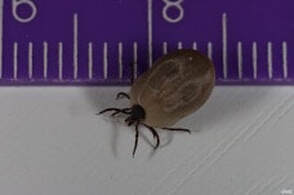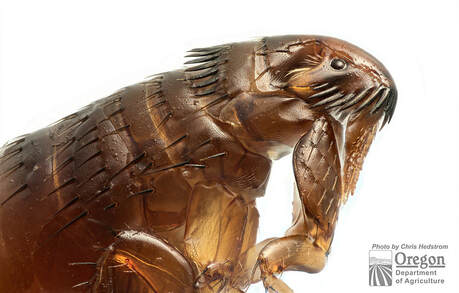|
For many of us, pets are an integral part of the family. We often give them the same love, affection, and attention that we give to a human family member. They typically sleep, play, eat, and travel with us—engaging in many of the same activities that humans do. Unfortunately, that means that they are susceptible to many of the dangers that we are, and that includes attack by insect pests. In this week’s blog we discuss insect/arachnid threats to our furry friends and how to keep our pets happy, healthy, and pest-free. PESTS THAT AFFECT PETS1. TICKS Ticks are exceptionally dangerous for pets, especially those that spend the bulk of their time outdoors. Because they attach to animals and feed on blood for multiple days, they are exceptionally good at transferring microbes into the bloodstream of their host. Deer ticks are probably the bad guys you’ve heard of most—as they can transmit Lyme disease. In dogs, this could manifest in lameness, joint swelling, fatigue, and loss of appetite. In severe cases, there are serious kidney complications associated with Lyme disease in dogs, too. Lyme disease is caused by an infection with a bacterium, Borrelia burgdorferi that is spread to people and animals through tick bites. Animals typically show signs of chronic infection 2-5 months after infection. In addition to Lyme disease, dogs are also susceptible to an array of other diseases transmitted by ticks, including canine ehrlichiosis, anaplasma, Rocky Mountain spotted fever (RMSF), babesiosis, bartonella, and hepatozoonosis. Some of these are debilitating and when they are, they are often fatal. Ticks not only affect dogs, but they impact the health of cats, too. Ticks can transmit multiple diseases to cats including cyauxzoonosis, tularemia, anaplasmosis, and of course, Lyme disease. Infection with pathogens that cause these diseases can cause secondary infections, anemia, and tick paralysis—which can be life threatening. To prevent ticks from latching on to your furry friend(s), take a two-pronged approach that includes speaking with a veterinarian and modifying the lawn and landscape to be less tick-friendly. First and foremost, take your pet in for a check-up with your primary veterinarian and discuss a tick prevention product that works best for you. Although over-the-counter tick prevention is available and can be efficacious, your vet will know which of these are appropriate for your pet based on their medical history. Additionally, there are multiple product forms available and making an informed choice can feel overwhelming. Most oral and topical products require you to reapply once a month, or once every few months. Make sure to log these dates in your calendar so you do not forget! Missing an application gives ticks a window to attack your unprotected pet.
For more information on tick distribution, life cycle, and habits, see this handy website from the Centers for Disease Control and Prevention. 2. FLEAS Fleas are small, blood sucking insects that have plagued animals since, basically, the dawn of time. It is unlikely that an animal will contract a disease from flea bites, but there are certainly a number of health risks that fleas pose to pets, and people too. Fleas can transmit both plague and murine typhus (although this is rare). More commonly, fleas cause parasitic dermatitis. This is a problem that arises when pets are allergic to flea saliva; flea-related dermatitis can cause inflammation, dramatic hair loss, and infection. Certain tapeworms are passed to animals from fleas, too. Finally, flea infestations can lead to cat scratch fever—an infection caused by the bacterium Bartonella henselae (see link above). Unlike ticks (excluding the brown dog tick) fleas can survive and reproduce in the indoor environment. This means that an additional approach is needed for flea management when we compare flea infestations to tick infestations. In addition to treatment of the animal and management of the lawn, steps must be taken indoors as well to eradicate fleas. If you see your pet itching more than normal, see small “pepper flakes” (flea poop) on your pet’s skin or in the environment, and notice small, jumping insects on your pet—it is time to take action. Ideally, you can stop a flea problem before it starts. This involves taking the steps we outlined above in the tick section. Talk to your veterinarian about flea prevention products, which luckily tend to treat prevent ticks, too! Once that has been taken care of, you can use a flea comb to remove fleas that are present, or, as a preventative tool to make sure no fleas are around. If your pet has an active flea problem, wash them with a medicated shampoo (your vet can recommend a suitable product). These shampoos are drying to your pet’s skin and should not be used for long-term flea treatment or prevention. Because fleas thrive in environments that pets frequent, it might be a good idea to hire a pest management professional to conduct a lawn and perimeter pesticide treatment. This is not always necessary, but may be prudent when fleas have been an ongoing problem. They are also able to treat the indoor environment to reduce the number of fleas you see while you are engaging in other treatment methods. Fleas are an issue that cannot be solved with pesticides alone, though. Eggs and larvae (juvenile fleas) must also be addressed in order to prevent the cycle from starting again. Be sure to launder infested items and vacuum the home frequently. These practices will not only remove fleas, but they will also remove flea droppings from the environment, which juveniles need to feed on to survive. Finally, avoid using over-the-counter flea bombs indoors. Pesticide does not often get to the areas where fleas are harboring and fleas are becoming resistant to the active ingredients used in many of these products. CONCLUSIONSFleas and ticks are not a problem you should ignore. Flea and tick bites pose significant risks to animal health in addition to making pets uncomfortable due to scratching and allergic reactions that can follow. It is important to place your pet on a preventative treatment year-round to keep fleas and tick populations from building up in and around the home where they may start biting people, too. Entomologists are a great resource for pest management in the environment, but for fleas and ticks—make sure you discuss a prevention plan with your veterinarian, too. Do not be fooled by cheap products that make bold claims. There is no miracle product or solution and treatment takes patience, especially for fleas. However, the comfort your best friends enjoy once they are pest-free makes it all worth it, right? Be on the lookout for our next piece which will cover mosquitoes and stinging pests!
0 Comments
Your comment will be posted after it is approved.
Leave a Reply. |
Bug Lessons BlogWelcome science communicators and bug nerds!
Interested in being a guest blogger?
Archives
November 2023
Categories
All
|

